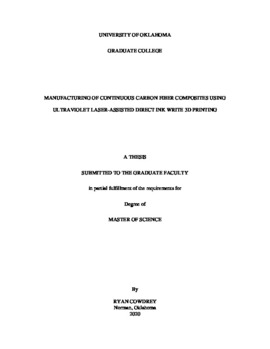| dc.description.abstract | Additive manufacturing (AM), commonly referred to as 3D printing, is a quickly growing field
with numerous techniques available to manufacture parts which are stronger, lighter, and more
complex than those which could be traditionally manufactured. With the goal of creating stronger
parts, a new 3D printing technique was developed which combined properties of several different
methods in order to print continuous carbon fiber-reinforced thermosets. This new method is called
continuous fiber direct writing (CFDW). The process works by extruding continuous fiber and
ultraviolet (UV) curable resin out of a syringe simultaneously and curing the resin immediately
upon extrusion via UV lasers aimed at the extrusion point. This was created using the principles
behind direct ink writing (DIW), stereolithography (SLA), and fused deposition modeling (FDM).
It utilizes DIW technology to extrude liquid resin out of the syringe, SLA technology to cure the
resin in situ, and FDM technology to deposit the fiber and resin onto the print path. In order to test
this novel method, a custom extrusion system and print head was designed and adapted onto an
existing consumer FDM printer. The developed printer is able to successfully print continuous
fiber-reinforced samples with control over the fiber direction and fiber volume fraction. Several
experiments were conducted in order to characterize the various printing parameters. The largest
focus was on the two most important parameters: deposition speed and extrusion pressure. The
deposition speed, or feed rate, describes how quickly the print head moves across the build plate,
while the extrusion pressure describes how much pressure is applied to extrude the resin out of the
syringe. These two parameters together greatly affect the resulting width and shape of a printed
line of fiber. In general, increasing the pressure or decreasing the feed rate creates a larger line
width. This is very important as it affects the hatch spacing which in turn affects the fiber volume
fraction. Additionally, these factors can affect the top surface finish of the resulting part. In addition to these parameter-based studies, bulk rectangular samples and complex samples were
printed in order to demonstrate the capabilities of the printer. The CFDW method works well and
is fairly consistent with the proper printing parameters. Through future development of this
process, composite samples can be made with individual tows of fibers oriented according to the
geometry of the part, allowing for reduced weight and increased strength of the additively
manufactured components. | en_US |
